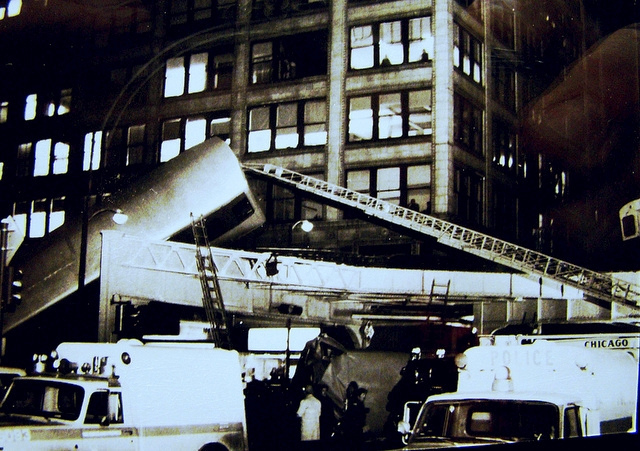Video: A Horrific Loop CTA Derailment Happened 39 Years Ago, Killing 11
By Sam Stecklow in News on Feb 5, 2016 5:23PM
For the first few months after I moved to Chicago (and, depending on the line, sometimes to this day), the L was a regular source of anxiety. Having moved here from the San Francisco area, where city public transit is largely on or under the ground, being at office-building level in a rush hour train full of people was a prospect I'd never encountered before, and I always had a feeling in the back of my mind that the train would just flip over the guard rails after taking one of those rickety Loop turns a little too hard.
Had I moved here in the mid-70s, that feeling in the back of my mind would have been correct. In 1977, 39 years ago this week, the deadliest CTA derailment took the lives of 11 Chicagoans. During rush hour on Feb. 4, after switching issues forced the Evanston Express (now the Purple Line) to go counterclockwise on the outside track around the Loop, as opposed to their usual clockwise. One of them stopped to pick up passengers at State/Lake, as a Ravenswood train (now Brown Line) that usually operated on the outside track waited behind it.
At 5:25 p.m., the operator of a Lake-Dan Ryan train (now the Green and Red Lines), ignoring alerts from the signaling system in his front car, left the Randolph/Wabash station and proceeded around the bend at Lake and Wabash, colliding lightly with the idling Ravenswood train—passengers reported that it felt like nothing beyond a slight bump.
What killed 11 people and injured hundreds was the fact that after the collision, the Lake-Dan Ryan operator continued to apply traction power—basically, he kept his foot on the gas. Since the Ravenswood train stopped at a right-angle turn, it was essentially an immovable force. The first three cars of the Lake-Dan Ryan train were pushed upwards until they jackknifed, the first car falling to a support structure and the second and third cars falling onto the street below. "People fell out of the train and the train fell on top of them," a witness told the AP.
Firemen and police officers, as well as Mayor Michael Bilandic, were on the scene almost immediately, and wreckage was cleared after 12 hours, which feels pretty good for an incident in which two complete CTA cars fell into a busy intersection at rush hour. However, it was the second deadly CTA derailment in 13 months.
The crash was blamed on the operator of the Lake-Dan Ryan train, Stephan Martin. Chicago-L blogger Graham Garfield explains the case against him:
"[Martin], while approaching the Randolph/Wabash station, got a restrictive signal indication and the alarm in his cab went off. But, making the normal station stop, he inadvertently overrode the signal, which allowed him to proceed. He left the station and proceeded under 15 mph, which prevented the automatic braking from engaging. What happened next is open to speculation. Some say that Martin, who was known to talk to passengers (especially female ones) while motoring, was doing just that while approaching the Ravenswood train ahead and didn't see the impending collision. When his train struck the stopped Ravenswood, it is believed that he either panicked and accidentally applied more power instead of braking or that the sheer force of the impact threw him forward and, as a result of his hand being on the Cineston controller, threw the control forward as well."
Drug tests found that he had cannabis in his system, but a 2011 Claflin University study found that drug test kits used by police often give false positives for cannabis. (Additionally, cannabis stays in your system, and will be detected by drug tests, for days after initial use.)
Ten years after the incident, the Tribune followed up with passengers of the train. Dolores Gunderson said, "We were being whipped back and forth, like at the end of a whip almost. The car was being shaken like a toy. That`s when I fell to the floor and somebody—accidentally, of course—stepped on my head." Donald MacCorquodale, who witnessed the crash, said, "On the fourth rocking motion, (the first four cars) just went all the way over and fell into the street. It was an almost slow-motion event. It was not a split-second event. You could really see all of this happening."
The crash prompted shifts in policy for the CTA. "The transit authority installed barrier girders on the four sharpest curves of the rail system; retrained train operations cited for moving violations; and began requiring its train operators to get permission from the control center before proceeding past a red signal 'on sight,'" Chicago History Museum Director of Curatorial Affairs told DNAinfo.
Despite those new policies and safety features, ten years later, at the same turn, 25 people were injured in eerily similar circumstances. Despite repeated warnings, a CTA motorman crashed into an idling train at five miles over the speed limit of the area.
